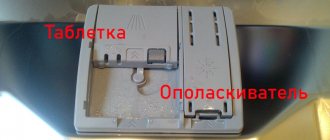How much do dishwashers weigh, what types are they?
This is the 21st century - a time of high technology, in which a person simplifies his life as much as possible, surrounding himself with various equipment. Almost every home now has a TV, computer, refrigerator, gas stove, vacuum cleaner, washing machine, etc., and all these are no longer luxury items, but daily attributes of a comfortable life. Recently, the list of such attributes has been supplemented by a dishwasher, first widely used in Europe, and now here in Russia, which is not at all surprising: why wash mountains of dishes every day if a dishwasher can do it for you?
Using a dishwasher will save a lot of time, which you can spend on much more enjoyable things than washing dishes. But how to choose a dishwasher that suits you and can serve you well for many years?.. The available offers in stores are enough for the buyer to be puzzled by the question of choice. When choosing a specific type of machine, the number of programs, energy and water consumption class do not play a special role; the main characteristics of dishwashers are weight, type of construction, washing class and drying class.
The weight of the dishwasher directly depends on its dimensions, which also affects the capacity of the dishwasher, and ranges from 17.0 to 60.0 kg. Most dishwashers are approximately 45 to 60 cm wide and come in three sizes: standard, narrow and compact.
Principle of operation
The dishwasher ensures impeccable cleanliness of dishes and kitchen utensils due to the fact that the heating temperature of the water in the machine reaches 60 degrees, which means that the active components of detergents cope more effectively with any type of dirt.
In addition, this technique additionally dries the dishes, preventing the appearance of streaks and water stains on them.
Complete removal of dirt and grease from kitchen utensils is carried out using a water jet supplied from the machine’s rocker arm at speeds of up to 150–160 km/h. Dirty wastewater is discharged into the lower compartment for thorough filtration and recirculation.
Expensive models are equipped with special filters in which cleaning is performed automatically, and accumulated dirt is removed through a drain pump into the sewer.
Automatic intake of the required volume of water is carried out by a built-in pump through a bypass valve, which is located at the point where the hose connects to the body of the device.
There is also a standard filter - a mesh, which is designed to retain large pieces of debris. The central pump supplies water through a pipe to the rocker arms.
From 40 to 55 kg
The standard size of a dishwasher is 60x60x85. This dishwasher is designed for 10-14 full sets of dishes and is ideal for a family of up to five people. It is advisable to use a standard dishwasher once a day with a full load. These dishwashers have greater productivity than other types, as well as a great variety of different modes and all sorts of additional functions. Standard dishwashers are the most economical. Such devices weigh from 40 to 55 kg or a little more.
Advantages
Key benefits:
- Simplicity and efficiency of the process of washing kitchen utensils at any time of the day;
- To use the machine, it is not necessary to have hot water supply;
- Washing dishes in a machine can reduce water consumption by almost 5 times;
- For the dishwasher, it is allowed to use strong detergents that have a negative effect on human skin;
- Dishes are rinsed at high temperatures, which effectively removes detergent residue.
Which is better
When choosing a PMM model taking into account the dimensions, it is necessary to take into account that the main parameters of the machine (width, height, depth) determine a number of other characteristics. The operating efficiency of the device will depend on this
When considering 3 types of machines (full-size, narrow, compact), pay attention to the compliance of the parameters with the service conditions. Thus, models with standard sizes are preferred if the purchase is planned for a large family (4 or more people) or if there are often guests in the house
Narrow models can also be used in facilities where many people live, but there is not enough free space. Moreover, in terms of capacity, such equipment is often not inferior to its full-size counterparts (the average is 10 sets of dishes). Narrow models are characterized by the same level of energy and water consumption as standard units, provided that the same amount of dishes can be placed inside the equipment.
In addition, the device is hidden behind the facade of the kitchen unit. In most cases, the dimensions of the built-in dishwasher (45 cm width) allow the unit to wash large volumes of dishes in 1 cycle. This means that in terms of efficiency, such devices often even outperform their full-size counterparts.
Mini-PMMs are in demand in small kitchens, as well as if the family is small (2-3 people). The dimensions of the built-in devices allow for hidden installation behind the facade of the kitchen unit (in the cabinet, under the sink). As a result, even more space is saved. This option is efficient, functional, and costs less.
Types of dishwashers
Types and their sizes
The design features of such equipment include choosing a suitable place in the kitchen or bathroom for connection to a water riser, sewer drain and electrical outlet.
By installation method
According to the installation method, modern models can be divided into two types: free-standing and built-in (with partial or complete installation).
Freestanding - have their own body with a tabletop lid. Such machines are more accessible to install, maintain and are cheaper compared to their built-in counterparts. In some models, the top cover is removable, so it can be replaced if necessary.
Built-in – selected at the stage of designing a kitchen unit. You can choose models with full embedding or partial, when the top panel remains open.
Fully built-in – they are installed in a furniture set, so outwardly they become almost invisible to prying eyes. The control panel is also securely hidden behind the decorative facade, but is available for starting the device and selecting the operating program.
partially built-in devices , the control panel is located on top of the decorative facade and provides quick access to the machine.
Dishwashers of standard sizes
First, let's figure out how many cm a dishwasher has standard dimensions? It is generally accepted that the standard dimensions W x D x H are 60x60x85 cm, but not everything is so simple. Standard fully built-in machines are not suitable for these dimensions. The width is basically 60 cm for all, but the depth is 55 cm, 60 cm, and 57 cm. The height is also different - 80 cm, 81.5 cm, 82 cm and so on. You can read more about the sizes of dishwashers in the article of the same name published on our website.
How much do 60 cm dishwashers weigh? Let's give examples of several models and brands of 60 cm wide machines and see.
- BOSCH SMV50M50RU – 37 kg.
- BOSCH SMV53N20RU – 39 kg.
- BOSCH SMV50E10RU – 35 kg.
- BOSCH SMV30D30RU ActiveWater – 31 kg.
Important! Experts note that the smaller the weight of a 60 cm dishwasher, the inevitably louder it works, because a heavy counterweight dampens the negative impact of centrifugal force, and therefore the sounds produced by vibrating and swaying equipment.
- GORENJE GV6SY2B – 45 kg.
- GORENJE GV6SY2W – 45 kg.
- GORENJE GV 64311 – 42 kg.
- GORENJE GV 63311 – 41 kg.
The average dimensions of GORENJE brand dishwashers W x D x H are 59 x 55 x 81 cm. Their weight is not much more than BOSCH dishwashers of similar size and design, as is the noise level they emit.
- Electrolux ESF9862ROW – 46 kg.
- Electrolux ESF9862ROX – 45 kg.
- Electrolux ESF9551LOX – 42 kg.
- Electrolux ESF9520LOW – 45 kg.
The bulk of full-size 60 cm Electrolux dishwasher models are quite lightweight. Their weight is within 45 kg. But at the same time, tests show that both the noise and vibration levels of these machines are within normal limits. Why so, how is it possible to dampen centrifugal force without counterweights. The secret lies in the unique arrangement of parts. The motors and moving parts are located so that minimal vibration occurs, and the body remains stable at a relatively low weight.
Dimensions: height, depth, width
Depending on the size, the following types are distinguished: full-size, compact and narrow.
Full-size - they are standard-sized devices that can be installed on the floor or mounted in a kitchen unit.
Compact - designed for installation on a table or cabinet due to its small size.
With a standard height, narrow ones differ in width and depth. They can be installed both in furniture and on the floor.
Overview of standard models
Let's start with models that have standard dimensions. These include machines with parameters of width, depth and height - 60x60x85 cm. But this applies only to stationary PMMs, and fully built-in ones differ in depth - 55, 57 or 60 cm. The height also ranges from 80 to 82 cm due to the fact that A tabletop is also installed on top.
Fact! Experts are sure that the less a dishwasher weighs, the noisier its operation.
Let's consider the mass of standard PMMs using the example of the manufacturer Bosch (Bosch).
Stationary (in kg):
- Serie 2 SMS24AW01R - 43
- Serie 2 SMS24AW00R - 43
- Serie 4 SMS44GI00R - 48
- Serie 4 SMS44GW00R - 48
Built-in (in kg):
- SMV 25EX00 E - 33
- Serie 8 SMV87TX01R - 39
- SMV 25CX03 E - 34
- SMV 68TX03 E - 43
Developers from Bosch have achieved effective vibration damping without the use of a counterweight thanks to a unique arrangement of parts. All main components are located so that vibration is minimal, and the equipment, despite its lightness, remains stable. Therefore, Bosch PMMs rarely weigh more than 48 kg.
Selecting a tabletop dishwasher
How much do compact PMMs weigh? On average, this figure is 20-25 kg. Counterweights simply do not fit in them, so the main mass consists of parts and the body. Stability is ensured by its modest height and impressive width. But, judging by user reviews, the machines are still prone to jumping and vibration and are noisier than similar narrow or full-sized PMMs.
Weight parameters of compact structures of different brands (in kg):
- Candy CDCP 6/E - 22.5
- Candy CDCP 6/ES - 22.5
- Midea MCFD-0606 - 22
- Hotpoint-Ariston HCD 662 S - 22.5
- Bomann TSG 708 white - 23
- Electrolux BLACK line ESF 2400 OK – 21
- Electrolux ESF 2400 OH - 21
We can conclude that a small dishwasher weighs as much as a large microwave oven.
Why is it important to know all the parameters of a small machine? It's simple: if you are going to place it on a shelf, under a sink or in another place, you need to provide for all the nuances in advance so that the surface can withstand the structure.
What affects weight?
There are many factors that influence how much a dishwasher weighs, but the main ones can be identified. Understanding the internal structure of the equipment will help you understand the essence of the issue. Some parts of the device are so heavy that they account for the lion's share of the mass.
- The bunker occupies the main internal volume of the equipment and has an impressive weight, because often made of stainless steel.
- The pump and circulation pump are located in the pan. It is difficult to determine the exact weight of each part; it is easier to highlight the total mass - the entire pallet weighs up to 12 kg.
- The machine body, dish boxes and rocker arms weigh about 10 kg.
- Up to 3 kg per hopper door.
The total mass of all parts will be about 25 kg. But often manufacturers declare such figures - 50, 55 or more kg. A completely logical question is brewing: where did the 30-odd kilos come from? The answer still lies in the internal structure of the unit.
Narrow and compact cars
Now let's talk about how much narrow dishwashers with a width of 45 cm weigh. Generally speaking, the weight of 45 cm dishwashers is about 5-7 kilograms less than the weight of similar full-size dishwashers of the same brand. Although there are more serious discrepancies, let's look at specific examples.
- Bosch SuperSilence SPS53M52RU – 41 kg.
- Siemens SR26T897RU – 45 kg.
- Electrolux ESF9450LOX – 36.5 kg.
- Hansa ZWM4577WH – 37 kg.
Experts say that in order to achieve good stability, a narrow dishwasher (with a height of 85 cm and a width of 45 cm) must have a correctly distributed weight of at least 40-45 kg. Models that weigh less, one way or another, lose in terms of stability.
Note! If you believe consumer reviews, the Electrolux ESF9450LOX or Hansa ZWM4577WH dishwasher models are indeed noisier than the Siemens SR26T897RU.
Now let's say a few words about small or tabletop dishwashers. How much do they weigh? Compact dishwashers weigh on average 20-25 kg . The main weight is made up of parts and the body; there is simply nowhere to shove counterweights into such machines, although some manufacturers manage to do this. The stability of a small car is given by its low height and relatively large width.
Having the shape of a parallelepiped, the machine, in theory, should be better able to withstand centrifugal force, but that was not the case. In fact, without heavy counterweights, the car has a hard time. During intensive washing, some models of small dishwashers vibrate and jump, producing quite a loud noise. Tests have shown that such machines are even noisier than their “full-size counterparts,” all due to lack of weight and compact arrangement of parts.
- Bosch ActiveWater Smart SKS62E88RU – 21 kg.
- Flavia TD 55 Valara – 26 kg.
- Candy CDCF 6S-07 – 21.8 kg.
- Bosch SKS51E22RU – 21 kg.
In conclusion, we note that dishwashers of any type do not have a standardized weight, nor do they have a standardized size. Different brands and models of dishwashers have different weights. To find out how much a standard 60 cm wide dishwasher weighs, you need to open the instructions for the model you are interested in and see how much it weighs. Happy research!
Varieties
You have decided that you need a dishwasher - what next?
First, select the type of miracle unit. Dishwashers can be countertop or non-built-in, built-in, partially built-in. Let's get acquainted with each type separately below.
A tabletop dishwasher is a compact machine about the size of a microwave oven. In one cycle, this “baby” will clean 5 sets of dishes on average. It is quite enough for a family of three or a bachelor.
Built-in - such a device is completely built into the kitchen set. The facade is hung on the front panel. This is the most typical, rational setting for a new acquisition. This way the appearance of your kitchen will not be spoiled.
Partially built-in - a device that is only partially built into the headset. In case you do not want to install a facade or the device does not fit in its dimensions.
How to choose a built-in dishwasher?
If you are wondering how to choose a built-in dishwasher, we want to give some recommendations on choosing the right equipment:
Built-in type - as already mentioned, dishwashers can be partially or fully built-in. Decide which type suits you best.
Dimensions - there is usually no point in remaking a headset for a new purchase. The best solution would be to take preliminary measurements and then go to the store.
Software - drying, dish cleaning mode, water temperature, all this is controlled by the program. Everyone is able to choose the functionality for themselves.
The snooze timer is a very useful feature. With it, you can save even more by shifting dishwashing to the night (electricity will be cheaper). This is also a great way out for those who don’t stay at home. I set a timer and the equipment will start on its own and clean everything.
Water restoration - modern units themselves achieve the required water hardness levels. Dishes are sensitive to this
Therefore, it is better to pay attention to new models.
Protection against leaks - these days there are special hoses with the AquaStop system. If there is the slightest chance of leakage, water will not come out of the device.
Countertop dishwasher: which one to choose?
If you have a spacious kitchen, you can buy any dishwasher listed above. But what to do when you are cramped for space, the kitchen is small, and a miracle unit is so desired? A countertop dishwasher would be a good solution. Which one to choose from the whole variety of models?
The best option would be the Bosch SKS series. Let's take a closer look at one of the models. Our choice is Bosch SKS 60E18RU. These little ones can hold 6 sets of dishes and have several washing modes.
Bosch SKS 60E18RU
Load sensor, timer, product recognition - everything is the same as its “big” brothers. The 60E18RU is distinguished only by its dimensions.
It is, of course, up to you to decide whether or not to buy a new device for your kitchen. But I would like to note that even a small unit will greatly facilitate housework.
Characteristics of dishwashers
Weight
The overall weight of a dishwasher is determined by its design and functionality. It is noteworthy that the lower the noise level during operation, the greater the weight of the equipment. In addition, the weight is increased by additional mechanisms that ensure low consumption of electricity and water.
Korting KDF 2050 S
The rating of the smallest dishwashers under the sink is completed by a model whose cost starts at 23,000 rubles. But this cost is fully justified by the high reliability of the equipment, which comes with a 2-year warranty, electronic control, and effective condensation drying. The dishwasher has a digital display, 7 modes and a self-cleaning function.
The advantages of the model that completes the review include quiet operation, with a noise level of up to 49 dB, water consumption of 6.5 liters per three-hour cycle, height of 43.8 cm and a long power cord. And the disadvantages are a plastic smell in the first weeks of use.
Where does the “excess weight” come from?
Often designers install counterweights. These are special stones or blocks that give the equipment stability during operation. Dishwashers do not have such heavy and bulky counterweights as washing machines, because they work more quietly, because... there is no need to “squeeze” and thereby swing the body. But, nevertheless, they are used to prevent fragile dishes from breaking as a result of exposure to centrifugal force.
Turbo drying is a functionality that also makes the case heavier. If the drying is not ordinary condensation, but “Turbo”, it means that a motor, heating element and fan are built into the housing.
The “completeness” of the equipment is also slightly affected by the presence of a heat exchanger, additional facade panels and other parts.
On a note! Freestanding structures are usually heavier due to the double shell and internal insulation. The built-in machine weighs approximately 1.5 kg less.
type of instalation
Depending on the installation method, the dishwasher can be built-in or free-standing. Built-in models are purchased in conjunction with a kitchen unit and are recommended for small spaces. There are partially built-in options with their own front door and an open control panel, and fully built-in ones - completely hidden behind a decorative facade.
The most important characteristics of built-in dishwashers are their dimensions and level of protection against accidents. Options such as water hardness control, leakage indicator, and quality workmanship minimize the likelihood of breakdowns, which is important when installing the device inside furniture and thereby complicating its maintenance and repair.
Freestanding dishwashers are great because they can be placed in any suitable place in the kitchen, regardless of the furniture. They are easy to install and maintain. But such dishwashers should fit perfectly into the interior, without standing out against the background of the kitchen set and household appliances.
From 20 to 25 kg
Compact dishwashers are ideal for small apartments or cottages. Due to their small size, they are extremely easy to install. In addition to the fact that they can be installed at the sink or on the table, they can also be easily built into a bedside table or closet. Compact dishwashers are cheaper in price, but not as economical as narrow and standard ones, and their cleaning quality is lower. Compact dishwashers have dimensions of 45x55x45 and are designed for 4 standard sets of dishes. They also have the most minimal functional set. Their weight is no more than 30 kg, but most often 21-22 kg.











